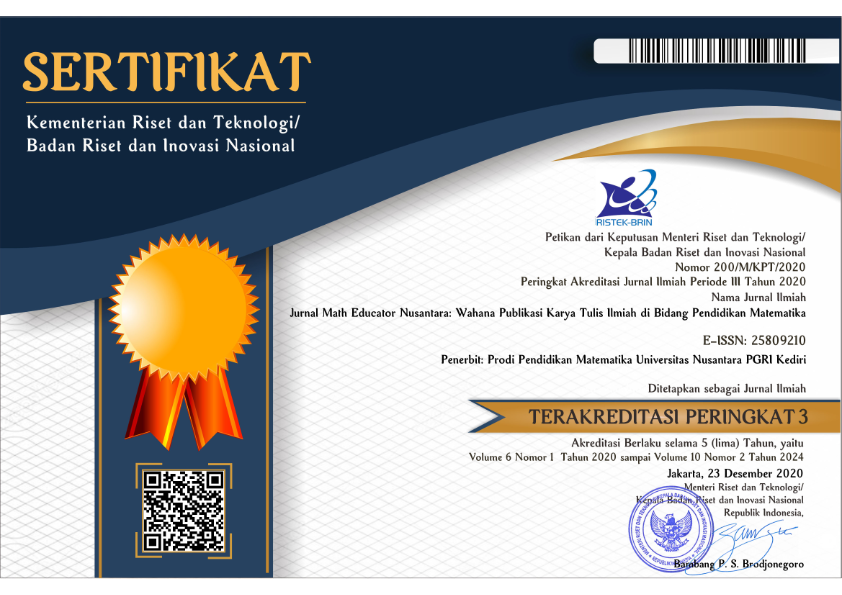Development of scale learning tools on map based on problems to improve problem solving skills
DOI:
https://doi.org/10.29407/jmen.v7i2.16153Keywords:
Learning Media, Problem-solving skills, Problem-based, Scale, MapAbstract
This study aims to describe the process of developing problem-based learning, analyze the results of the device development, describe student's problem solving with problem-based learning on the scale materials on the map. This research uses research and development (R&D) type, namely 4D-Model (Define, Design, Develop, and Disseminate). The developed learning tools are including; lesson plans (RPP), LKPD, and a problem-solving ability test (KPM). The results of the development of the scale learning device on the map is valid, practical and effective. The validity of the learning tools is as follows: the average RPP validation is 3.68 or 91.91% in the valid category; LKPD of 3.39 or 84.75% in the valid category; and the KPM test of 3.12 or 78% in the valid category. Therefore, based on the results of the assessment of the validator, problem-based learning tools can be used for learning activities. Practicality of learning tools: the ability of teachers to manage learning is 3.48 or the percentage of implementation is 87% with the category of good implementation; student activity in learning activities is 97.5%. Therefore, it could be claimed as effective. The effectiveness of learning tools: the percentage of changes in KPM of positive students is 75%; the increase in KPM gets an N-Gain score of 0.59 in the medium category, the completeness of percentage in classical learning is 90% thus, it could be claimed as complete, while the student response in positive learning is in an average score of 97 %. Based on the results of the research on the learning device scale on the problem-based map based on good criteria which is valid, practical and effective so that it can be used for learning activities.
References
Amir, M. F. (2015). Prosiding Seminar Nasional Pendidikan : Pembelajaran Konsektual terhadap Kemampuan Pemecahan Masalah Matematika Siswa Sekolah Dasar. (2011), 34–42.
Arends, R.I. (2012).Learning to teach. New York : McGraw-Hill
Arikunto, S. (2009). Prosedur Penelitian Suatu Pendekatan Praktik. Jakarta : Rineka Cipta
Chuan, T. Y., Rosly, N. B., Bin Zolkipli, M. Z., Wei, N. W., Basheer Ahamed, M. A. Bin, Binti Mustapha, N. A., … Zakaria, Z. (2011). Problem-based learning: With or without facilitator? Procedia - Social and Behavioral Sciences, 18, 394–399. https://doi.org/10.1016/j.sbspro.2011.05.057
Cindy E. Hmelo-Silver1, 2. (2004). Problem-Based Learning: What and How Do Students Learn? Educational Psychology Review, 16(3), 235–266.
Dewi, H. D., Susanto, & Lestari, N. D. S. (2015). The Development of Instructional Design Standard NCTM (National Council of Teachers of Mathematics) About Statistics Topic for Seventh Grade of Junior High School. Jurnal Edukasi, 2(3), 25–30.
Farenkel, Jack R and Wallen, Norman E. (1990). How to design and evaluate Research In Education Seventh Edition. New York : McGraw-Hill
Hadi, S., & Radiyatul, R. (2014). Metode Pemecahan Masalah Menurut Polya untuk Mengembangkan Kemampuan Siswa dalam Pemecahan Masalah Matematis di Sekolah Menengah Pertama. EDU-MAT: Jurnal Pendidikan Matematika, 2(1), 53–61. https://doi.org/10.20527/edumat.v2i1.603
Hendriana, H., Johanto, T., & Sumarmo, U. (2018). The role of problem-based learning to improve students’ mathematical problem-solving ability and self confidence. Journal on Mathematics Education, 9(2), 291–299. https://doi.org/10.22342/jme.9.2.5394.291-300
Hobri, Ummah, I. K., Yuliati, N., & Dafik. (2020). The effect of jumping task based on creative problem solving on students’ problem solving ability. International Journal of Instruction, 13(1), 387–406. https://doi.org/10.29333/iji.2020.13126a
Hobri. (2010). Metode Penelitian Pengembangan (Aplikasi Pada Penelitian Pendidikan Matematika). Jember: Pena Salsabila.
Ibrahim, M. (2012). Pembelajaran Berbasis Masalah. Surabaya : Unesa University Press
Jatmiko, J. (2018). Kesulitan Siswa Dalam Memahami Pemecahan Masalah Matematika. JIPMat, 3(1), 17–20. https://doi.org/10.26877/jipmat.v3i1.2285
Khasanah, A. F. (2018). Pengembangan Soal Cerita Menggunakan Komik Matematika Bernuansa Islami Pada Materi Perbandingan Kelas VII. 1–105.
Krismayanti, R., Sumarmo, U., & Maya, R. (2019). Peningkatan Kemampuan Memecahkan Masalah Matematika Dan Self Efficacy Melalui Pembelajaran Berbasis Masalah. Edusentris, 5(1), 47. https://doi.org/10.17509/edusentris.v5i1.293
Luksiana, E., & Purwaningrum, J. P. (2018). Model Pembelajaran Core untuk Meningkatkan Kemampuan Pemecahan Masalah Matematis Berbantuan Media Batik. ANARGYA: Jurnal Ilmiah Pendidikan Matematika, 1(2), 98–102. https://doi.org/10.24176/anargya.v1i2.2936
Marlina, R., Nurjahidah, S., Sugandi, A. I., & Setiawan, W. (2018). Penerapan pendekatan problem based learning untuk meningkatkan kemampuan pemecahan masalah matematis siswa kelas VII MTs pada materi perbandingan dan skala. JPMI (Jurnal Pembelajaran Matematika Inovatif), 1(2), 113. https://doi.org/10.22460/jpmi.v1i2.p113-122
Mayasari, T., Kadarohman, A., Rusdiana, D., & Kaniawati, I. (2016). Apakah Model Pembelajaran Problem Based Learning Dan Project Based Learning Mampu Melatihkan Keterampilan Abad 21? Jurnal Pendidikan Fisika Dan Keilmuan (JPFK), 2(1), 48. https://doi.org/10.25273/jpfk.v2i1.24
Meilani, D., Dantes, N., & Tika, I. N. (2020). Pengaruh Implementasi Pembelajaran Saintifik Berbasis Keterampilan Belajar Dan Berinovasi 4C Terhadap Hasil Belajar IPA Dengan Kovariabel Sikap Ilmiah Pada Peserta Didik Kelas V SD Gugus 15 Kecamatan Buleleng. Jurnal Elementary: Kajian Teori Dan Hasil Penelitian Pendidikan Sekolah Dasar, 3(1), 1-5.
Mufidah, L., Effendi, D., & Purwanti, T. T. (2013). Penerapan Model Pembelajaran Kooperatif Tipe Tps Untuk Meningkatkan Aktivitas Belajar Siswa Pada Pokok Bahasan Matriks. Jurnal Pendidikan Matematika, 1(1), 117–125.
Muliyono, M. R., Suyanto, T., & Turhan Yani, M. (2019). The Effect of Problem Based Learning Model on Understanding Concepts and Problem Solving Skill in Social Sciences in Grade IV Students of SDN 1 Mulung Driyorejo Gresik. International Journal of Scientific and Research Publications (IJSRP), 9(7), p9156. https://doi.org/10.29322/ijsrp.9.07.2019.p9156
Murdiana, I. N. (2015). Pembelajaran Pemecahan Masalah dalam Pembelajaran Matematika. Pendidikan Matematika, 4(1), 1–11.
NCTM (National Council of Teachers of Mathematics). (2000). Principles and standards for school mathematics. Reston, VA: Author.
Nieveen, N. (1999).”Prototype to reach product quality. Dlm. Van Den Akker, J., Branch, R.M., Gustafson, K, Nieveen, N., & Plomp, T. (pnyt)”. Design approaches and tools in educational and training. Dordrecht: Kluwer Academic Publisher.
Peraturan Menteri Pendidikan dan Kebudayaan 2016 No 22 Tentang Standar Proses Pendidikan Dasar dan Menengah Nomor 22 Tahun 2016. Jakarta : BNSP
Polya, G. (1973). How to Solve It a New Aspect of Mathematical Method. New Jersey : Princenton University Press
Purwanto. (2009). Evaluasi Hasil Belajar. Yogyakarta : Pustaka Pelajar
Putra, H. D., Thahiram, N. F., Ganiati, M., & Nuryana, D. (2018). Kemampuan Pemecahan Masalah Matematis Siswa SMP pada Materi Bangun Ruang. JIPM (Jurnal Ilmiah Pendidikan Matematika), 6(2), 82-90.
Ratumanan, T.G. (2006). Evalusi Hasil Belajar yang Relevan dengan Kurikulum Berbasis Kompetensi. Surabaya : Unesa University Press
Ratumanan, Tanwey Gerson & Theresia, Laurends. (2011). Penilaian Hasil Belajar pada Tingkat Satuan Pendidikan. Surabaya : UNESA University Press
Riduwan. (2010). Skala Pengukuran Variabel-variabel Penelitian. Bandung : Alfabeta.
Rohman, M/ dan Amri, S. (2013). Strategi dan Desain Pengembangan Sistem Pembelajaran. Jakarta : Prestasi Pustaka
Rustam E, S., Sidabutar, D. R., & Edy, S. (2017). Improving Learning Activity and Students ’ Problem Solving Skill through Problem Based Learning (PBL) in Junior High School. International Journal of Sciences: Basic and Applied Research (IJSBAR), 33(2), 321–331. Retrieved from http://gssrr.org/index.php?journal=JournalOfBasicAndApplied
Sanjaya, W. (2009). Strategi Pembelajaran Berorientasi Standar Proses Pendidikan. Jakarta : Prenada Media Group
Sariningsih, R., & Purwasih, R. (2017). Pembelajaran Problem Based Learning Untuk Meningkatkan Kemampuan Pemecahan Masalah Matematis Dan Self Efficacy Mahasiswa Calon Guru. JNPM (Jurnal Nasional Pendidikan Matematika), 1(1), 163. https://doi.org/10.33603/jnpm.v1i1.275
Sihaloho, R. R., Sahyar, S., & Ginting, E. M. (2017). The Effect of Problem Based Learning (PBL) Model toward Student’s Creative Thinking and Problem Solving Ability in Senior High School. IOSR Journal of Research & Method in Education (IOSRJRME), 07(04), 11–18. https://doi.org/10.9790/7388-0704011118
Simanungkalit, R. H. (2016). Pengembangan Perangkat Pembelajaran untuk Meningkatkan Kemampuan Pemecahan Masalah Matematis Siswa SMP Negeri 12 Pematangsiantar. MUST: Journal of Mathematics Education, Science and Technology, 1(1), 39. https://doi.org/10.30651/must.v1i1.96
Sinta, T., Yusuf, M., & Rahman, S. R. (2019). The Implementation of Learning Device using Problem-Based Learning Model t o Optimize Students ’ Science Problem -Solving Skill. International Journal of Active Learning, 4(1), 66–70.
Siswono, Tatag Y,E., (2018). Pembelajaran Matematika Berbasis Pengajuan dan Pemecahan Masalah.Bandung : P.T Remaja Rosdakarya
Sugiyono. (2013). Metode Penelitian Kuantitatif Kualitatif dan R&D. Bandung : Alfabeta
Sumartini, T. S. (2018). Peningkatan Kemampuan Pemecahan Masalah Matematis Siswa melalui Pembelajaran Berbasis Masalah. Mosharafa: Jurnal Pendidikan Matematika, 5(2), 148–158. https://doi.org/10.31980/mosharafa.v5i2.270
Sundayana, Rostina. (2014). Statistika Penelitian Pendidikan. Bangdung : Alfabeta
Supardi US, L. &. (2010). Pengaruh Konsep Diri, Sikap Siswa Pada Matematika, Dan Kecemasan Siswa Terhadap Hasil Belajar Matematika. Jurnal Cakrawala Pendidikan, 3(3), 341–352. https://doi.org/10.21831/cp.v3i3.362
Susanto, E., & Retnawati, H. (2016). Perangkat pembelajaran matematika bercirikan PBL untuk mengembangkan HOTS siswa SMA. Jurnal Riset Pendidikan Matematika, 3(2), 189. https://doi.org/10.21831/jrpm.v3i2.10631
Thiagarajan, Semmel, & Semmel, (1974). Instructional Development for Training Teachers of Exceptional Children. Source Book. Bloomington: Center for Innovation on Teaching The Handicapped.
Trianto. (2010).Mengembangkan Model Pembelajaran Tematik. Surabaya Prestasi Pustaka
Trisnawati, W. W., & Sari, A. K. (2019). Integrasi Keterampilan Abad 21 Dalam Modul Sociolinguistics: Keterampilan 4C (Collaboration, Communication, Critical Thinking, Dan Creativity). Jurnal Muara Pendidikan, 4(2), 455–466. https://doi.org/10.52060/mp.v4i2.179
Umar, W. (2016). Strategi Pemecahan Masalah Matematis Versi George Polya Dan Penerapannya Dalam Pembelajaran Matematika. KALAMATIKA Jurnal Pendidikan Matematika, 1(1), 59. https://doi.org/10.22236/kalamatika.vol1no1.2016pp59-70
Valdez, J. E., & Bungihan, M. E. (2019). Problem-based learning approach enhances the problem solving skills in chemistry of high school students. Journal of Technology and Science Education, 9(3), 282–294. https://doi.org/10.3926/JOTSE.631
Widjajanti, B. D. (2011). Problem Based Learning dan Contoh Implementasinya.
Wood, D. F. (2003). Problem based learning. Bmj, 326(7384), 328-330.
Yuhani, A., Zanthy, L. S., & Hendriana, H. (2018). Pengaruh Pembelajaran Berbasis Masalah Terhadap Kemampuan Pemecahan Masalah Matematis Siswa Smp. JPMI (Jurnal Pembelajaran Matematika Inovatif), 1(3), 445. https://doi.org/10.22460/jpmi.v1i3.p445-452
Downloads
Published
Issue
Section
License
Authors who publish with this journal agree to the following terms:
- Copyright on any article is retained by the author(s).
- The author grants the journal, the right of first publication with the work simultaneously licensed under a Creative Commons Attribution License that allows others to share the work with an acknowledgment of the work’s authorship and initial publication in this journal.
- Authors are able to enter into separate, additional contractual arrangements for the non-exclusive distribution of the journal’s published version of the work (e.g., post it to an institutional repository or publish it in a book), with an acknowledgment of its initial publication in this journal.
- Authors are permitted and encouraged to post their work online (e.g., in institutional repositories or on their website) prior to and during the submission process, as it can lead to productive exchanges, as well as earlier and greater citation of published work.
- The article and any associated published material is distributed under the Creative Commons Attribution-ShareAlike 4.0 International License
















